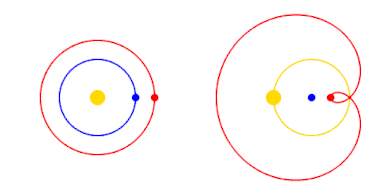Today (February 19, 1473) is the birthday of Nikolaus Kopernikus, who laid the groundwork for new development in astronomy by pioneering a revolutionary policy centred on the sun.

Nikolaus Kopernikus was born on February 19, 1473, in Thorne, Royal Prussia, Poland. His father was a big businessman in Krakow. Mother Barbara Watsonrad Thorn, daughter of the richest man in town. The couple had a fourth son, Nikolaus. His father emigrated from Krakow to Thorn, where he was a respected citizen. He was a wealthy copper merchant who died when Nikolaus was ten years old. After the death of his father, Nikolaus and his three siblings seem to have been raised by one of their parents. He never married until the end and focused his entire attention on his research. He was fluent in Latin, German, Polish, Italian and Greek.

In 1491 Kopernikus was admitted to the University of Krakow. It was here that he became accustomed to astronomy. He became interested in astronomy with the help of his teacher, Albert Brutsevsky. Four years later, after staying in Thorne for some time, he moved to Italy to study law at the University of Bologna. His uncle, Kopernikus, who financed his education, also wanted to become an archbishop. While studying there, he met teacher Domenico Maria Novara da Ferrara, a famous astronomer. Kopernikus studied with him and became his disciple and assistant.


According to Ptolemy's theory, the sun and the planets orbit the earth in large circles. The planets orbit in small orbits above these ranges. These small ranges were given as epicycles. Aristotle, he explored that everything, including the earth, revolves around the sun. He accepted the principles of land, water, air, and fire. He said that between the Earth and the Moon there are fixed planets like Mercury, Venus, Sun, Mars and Jupiter, which orbit the Earth in a fixed horizontal orbit.

Kopernikus' heliocentric principle is simple. However, the influence of Greek thought was also on his policy. According to Kopernikus' theory, the large orbits of the planets and small orbits are centred on the Sun. He included in his policy small circular arcs to illustrate the backward motion of the planets and their light differences. He also mentioned that the stars are located in the distant sky. Kopernikus' principle of rotation consists of seven parts. The celestial sphere has no common centre (especially the earth, which is mistaken for the centre of all). The centre of the earth is not the centre of the universe. It is the centre of gravity and the centre of the Moon's orbit. All the planets revolve around the sun. The distance from the Earth to the Sun is relatively small compared to the distance from the firmament where the stars are farthest from the Earth.

The Earth rotates daily on its axis. Distant galaxies appear to be moving due to the Earth's rotation, in fact, the galaxies are fixed on an immovable celestial body. The movement of the sun is not really the movement of the sun. The sensation that appears as the earth moves. The planets' backward motion and forward motion are not theirs. They are created by the movement of the earth. Kopernikus' view was not widely accepted by the general public and astronomers of the day, who did not accept that "Earth is not the centre of the universe, but an ordinary planet like the planets orbiting the sun." And because his book On the Revolutions of the Heavenly Bodies was in Latin, most people could not read it. Thus his thread was not proud.


It was only when Italian astronomers such as Galileo Galilei and Bruno adopted Kopernikus' principles and attempted to establish them that the world's view of Kopernikus fell on deaf ears. Its anti-religious policies were perceived by religious people. The book was banned in 1616, 73 years after its publication. This ban was not lifted until the end of the 18th century. Kopernikus was a physician, a judge, a governor, an economist, a mathematician, and a Catholic priest. However, he did not hesitate to publish a solar-centric policy against religious policies.


Kopernikus was a multidisciplinary expert, mathematician, astronomer, doctoral degree in law, physician, translator, archaeologist, Catholic priest, governor, ambassador and economist who played a major role in the European Renaissance. Nikolaus Kopernikus died on May 24, 1543, at the age of 70 in Bromberg, Poland, after exploring that everything, including the earth, revolves around the sun. Kopernikus died of a stroke and was in a critical condition. His book was printed and placed in his hands while he was in a coma, and he soon recovered from his coma and died after seeing his lifetime achievement book.
Source By: Wikipedia
Information: Ramesh, Assistant Professor of Physics, Nehru Memorial College, Puthanampatti, Trichy.
Get information like this
https://t.me/joinchat/jpqj3jQLN51kYTk9
Join Telegram Group.
https://chat.whatsapp.com/FisIzCe4Br2CRgxAiicUnf
Join WhatsApp Group
Thanks.
Also, Read
🛑👍 CSIR-NET Physics Materials and Problems
🛑📕 21 GB and Hundreds of Physics E-Books Collection.
🛑🛥️ How does an Electric Motor work? (DC Motor).
🛑🤹♂️ Science Academies' Summer Research Fellowship Programme for Students and Teachers 2022.
🛑🔌 How does a Transformer work - Working Principle electrical engineering.
🛑🎙️ Transistors Explained - How transistors work.
🛑🔥⚡ How Thermocouples Work - basic working principle.
🛑🔌 Voltage Explained - What is Voltage? Basic electricity potential difference
🛑🔌 What is CURRENT– electric current explained, electricity basics.


.jpg)
No comments:
Post a Comment